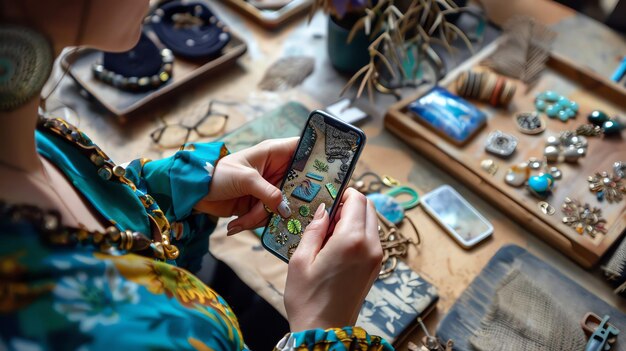In the digital age, social media has become a dominant force across all industries, reshaping how businesses operate and how consumers interact with products. The jewelry industry is no exception. Historically, jewelry brands relied on traditional methods such as print advertising, in-store experiences, and word-of-mouth recommendations. However, with the rise of social media platforms like Instagram, TikTok, and Pinterest, the jewelry industry is experiencing a fundamental shift in how it markets, sells, and connects with its audience.
One of the most significant ways social media is transforming the jewelry industry is by enabling direct communication between brands and consumers. Before the advent of social media, jewelry brands often had little interaction with their customers beyond the point of purchase. Now, through platforms like Instagram, Twitter, and Facebook, brands can engage directly with their customers, answer queries, and gather feedback. This direct interaction not only improves customer satisfaction but also builds trust and loyalty, as customers feel more connected to the brands they support.
Social media also allows for a more personalized shopping experience. Jewelry brands can use targeted advertising to reach specific demographics, ensuring their products are seen by the people most likely to be interested in them. Through algorithms and insights gathered from user behavior, social media platforms help brands create personalized ads that cater to individual preferences, leading to higher conversion rates and a more efficient marketing approach. For example, a luxury brand can target high-income individuals with ads showcasing their exclusive collections. While engagement rings such as designs by ethical jewellery from Lily Arkwright are good to use.
Moreover, the rise of influencers and brand ambassadors on social media has revolutionized how jewelry brands promote their products. Influencers, often with large followings on Instagram and TikTok, have become trusted voices in the fashion and beauty industries. By partnering with influencers who align with their brand values, jewelry companies can reach new audiences and gain credibility. Influencers often wear and promote jewelry in creative and authentic ways, creating aspirational content that resonates with their followers. This shift towards influencer marketing has become a key strategy for brands looking to increase visibility and drive sales.
Social media platforms also provide a unique opportunity for jewelry brands to showcase their products in a more dynamic and engaging way. Platforms like Instagram, which emphasize visual content, allow brands to post high-quality photos and videos that highlight the beauty and craftsmanship of their jewelry. Jewelry is inherently visual, and social media allows brands to leverage this visual appeal, showing off intricate designs and luxurious details that might otherwise go unnoticed in traditional advertisements. Additionally, the use of short-form video content, such as TikTok or Instagram Reels, allows brands to create more engaging and entertaining content, from behind-the-scenes looks at the design process to styling tips and tutorials.
User-generated content is another way social media is reshaping the jewelry industry. Brands encourage customers to share photos of themselves wearing their jewelry, often using branded hashtags or tagging the company’s account. This not only promotes the brand in an authentic way but also creates a sense of community. Customers love seeing real people wearing the jewelry they’re considering purchasing, and user-generated content helps potential buyers envision how the pieces will look in real life. In many cases, this type of content serves as free advertising, as satisfied customers become the best promoters of the brand.
Additionally, social media has made it easier for consumers to discover new and emerging jewelry brands. Before social media, smaller brands had a harder time breaking through the noise of the market and competing with established industry giants. Today, social media provides an equal playing field for all brands, allowing even the smallest jewelry makers to showcase their creations and build a following. Platforms like Instagram’s shopping feature and TikTok’s “Shop Now” option have made it easier than ever for consumers to purchase directly from the brands they discover online, bypassing traditional retail channels.
The jewelry industry has also witnessed a shift toward sustainability and ethical practices, largely driven by social media. Consumers, especially younger generations, are increasingly concerned with the ethical sourcing of materials and the environmental impact of their purchases. Social media has amplified these concerns, with influencers, bloggers, and brands themselves advocating for sustainable practices and transparency. Jewelry brands that align with these values are able to build strong connections with eco-conscious consumers, who are more likely to support brands that reflect their personal beliefs.
Finally, social media has created a new wave of trends and collaborations within the jewelry industry. Designers and brands now have immediate access to a global audience, and they can quickly capitalize on trends that emerge from online communities. For example, viral challenges or celebrity trends often spark a surge in demand for certain jewelry styles. In turn, jewelry brands can use social media to tap into these trends, creating limited-edition collections or collaborating with influencers and other brands to stay relevant and attract attention.
In conclusion, social media has undoubtedly changed the jewelry industry in profound ways. From transforming how brands communicate with consumers to providing a platform for smaller brands to rise to prominence, social media has leveled the playing field and created new opportunities for growth. As consumers continue to seek authenticity, personalization, and sustainability, the jewelry industry must continue to adapt to the ever-evolving landscape of social media, embracing new trends and technologies to stay ahead in the competitive market.

